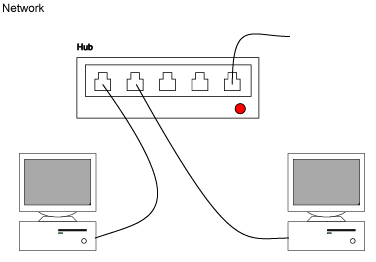W3C Web Accessibility Initiative
Leading the Web to its full potential
About WAI
About the Web Content Guidelines
Accessibility in XML and the future
Charles McCathieNevile, Jason White
The Web - Better for everyone?
Description
A cartoon I made. Somone in a wheelchair is at the bottom of the stairs. At
the top of the stairs is a computer, showing a red and a green button and the
word "VOTE!". A banner on the image proclaims "democracy"
Picture by Charles McCathieNevile ,
1999.
What is the World Wide Web Consortium?
World Wide Web Consortium (W3C )
What do we do at W3C?
About 65 members of the team (employed by W3C) work with around 50
groups
The groups are employees of member organisations, and invited experts..
They create and publish the standards of the Web (HTML, XML, etc)
The official language of W3C is English. The Internationalisation
activity
Coordinates translations of our publications
Ensures that our specifications are useful throughout the world
The Web Accessibility Initiative at W3C
W3C hosts the Web Accessibility Initiative (WAI )
One of four administrative divisions (domains) of W3C
representatives of industry, government, users and researchers
WAI has some additional sponsors
American (US, Canada) and European (EU) governments
Industry sponsors - Bell Atlantic, IBM, Microsoft and
others
How do we work?
Working groups operate under the process of W3C
WAI includes a high proportion of invited experts
The work is done via
Email lists (mostly public)
Telephone meetings (weekly or fortnightly)
Physical meetings (2 or 3 per year)
What does WAI do?
Ensure the accessibility of W3C's work
Create guidelines for accessibility
Develop tools to evaluate and repair accessibility
Conduct education and outreach
1. Ensure the accessibility of our work
WAI works with other groups in W3C on the accessibility of their
specifications:
HTML 4.0 , CSS2 :
Seperating the information's structure and content from its
presentation
SMIL , SVG
XLink, XHTML, DOM, Schemas, and others
Improving the accessibility of XML
2. Create Guidelines for Accessibility
We Work on More Guidelines
User Agent Accessibility
Guidelines
How to make accessible user agents (browsers, plugins, ...)
Accessibility of the software and communication with assistive
technology
Finished "Last Call". Hopefully published as a Recommendation early
2001
XML Accessibility Guidelines
How to create XML languages that support accessibility.
3. Coordinate Accessibility Tools
Coordinate research and development of tools to facilitate accessibility .
Evaluation of the accessibility of content
Repair tools
Tools to improve or repair the accessibility of content: rdfpic,
aprompt
Conversion tools
4. Conduct Education and Outreach Activities
Education & Outreach Working Group coordinates:
Promotional materials, brochures, films, ...
Simplified and education material (e.g. Quick Tips , Curriculum)
Outreach campaigns and presentations
Tracking policies and laws
Quick Tips
Now available in over 15 Languages
End of Part One
General Questions on W3C and WAI?
Part Two - Web Content Guidelines
Jason White - co-chair of the Working Group.
Purpose
Establish requirements and criteria for "accessible" web content
Provide a normative reference for conformance
Offer techniques/strategies to develop accessible sites
Provide the basis for related work
authoring tool guidelines
user agent guidelines
Early history
Early versions prepared by Trace R & D Centre, University of
Wisconsin
other guidelines developed by various organizations and individuals
Need for a single, broadly accepted, set of guidelines
Collection of requirements: review of all existing guidelines on web
accessibility
Incorporation of these ideas into Trace Centre Guidelines
Trace guidelines were submitted to the W3C.
Development of Web Content Accessibility Guidelines
Working group established in late 1997 (part of WAI technical
activity)
Guidelines developed through detailed discussion and
consensus-building
Public drafts: broad review solicited from interested individuals and
organizations
Guidelines approved as a W3C Recommendation May 1999
Web Content Accessibility
Guidelines 1.0
Structure of 1.0 Guidelines
Guidelines, checkpoints and techniques
Guidelines : general statements of access
requirementsCheckpoints : more concrete and specific
requirementsEach checkpoint assigned one of three priority levels
Conformance defined by priority levels of checkpoints
Techniques : how to apply checkpoints (e.g. in
HTML)Techniques document was recently updated
Why work on version 2.0?
Difficulty in applying 1.0 guidelines to new formats
Increasing use of XML formats on the Web
Broad range of skills and perspectives required
Define requirements in a more abstract manner
More specific techniques for various technologies
Different audiences will be familiar with different areas
Glimpse of current work
Drafts internal (but available to the public)
Development of 2.0 guidelines at an early stage
Drafts are not yet ready for public evaluation
2.0 requirements will be based on the 1.0 document
Comparison of cheeckpoints between 1.0 and 2.0 available
Outline of Requirements
Currently 6 guidelines in WCAG 2.0 draft
Text equivalents: content for varied modalities
Separation of content and structure from presentation
Designing for ease of comprehension
Designing for ease of browsing and navigation
Support for multiple input methods (keyboards, voice...)
Compatibility with browsers and adaptive technologies
Invitation to Participate
End of Part Two
Questions on Web Content Accessibility Guidelines?
Accessibility in the coming Web
XMLGL
XML allows people to create languages
Languages must support accessibilityfor browsers to use
XML Guidelines for making this happen
Demonstration of using them: SMIL, SVG, ...
Technologies to enable this: RDF, Xlink, ...
Summary of XML Guidelines
Similar to Web Content...
Rich alternatives for content
Structure and meaning in markup
Presentation support
Device Independence
User Control
Use existing standards
What is SMIL?
A language for synchronised presentations
Describes synchronisation for parts of a presentation
Images
Captions
Video (and more)
Version 1.0 is a W3C Recommendation (1998)
Version 2.0 in "Last Call" - the group thinks it has finished.
Example: "car"
What is SVG?
Scalable Vector Graphics
An XML language for images
Does many of the same things as Flash, but accessibly
Uses CSS for the style of a presentation
An example of SVG
Comparison
Bitmap Version
SVG Version
After magnification...
The bitmap version
And with SVG...
Text in SVG: Structure
HTML inside SVG
It is possible to use HTML or another
XML language within SVG to provide text with all the features (links,
structure, etc) of that language.
Alternatives in SVG
with CSS can be...
Network
Hub A typical 10baseT/100BaseTX network hub
Computer A A common desktop PC
Computer B A common desktop PC
Cable A 10BaseT twisted pair cable
Cable B 10BaseT twisted pair cable
Cable N 10BaseT twisted pair cable
and we can do better with XSLT
Network:
An example of a computer network based on a hub
With these components
Hub A typical 10baseT/100BaseTX network hub
Computer A and Computer B Common desktop PC
Cable A , Cable B and Cable N 10BaseT twisted pair cable
Captions (SMIL 1.0 and 2.0)
<!-- CAPTIONS -->
<switch>
<textstream src="carcaps.rt"
region="textregion" system-captions="on" />
</switch> Sign language captions...
Descriptions of video (SMIL 2.0)
<!-- Audio Descriptions -->
<audio src="card.au" systemAudioDesc="on"
systemOverdubOrSubtitle="overdub" />
<!-- Text Descriptions -->
<textstream src="cardc.rt" systemAudioDesc="on"
systemCaptions="on" />Control of the language (SVG and SMIL)
<!-- AUDIO -->
<switch>
<audio src="carnen.rm" systemLanguage="en" />
<audio src="carnde.rm" systemLanguage="de" />
<audio src="carnen.rm"/>
</switch> Accessible Animations
SMIL 2.0 and SVG provide a way to create accessible animations.
HIT ME!
There are examples in the Note
"Accessibility features of SVG".
Metadata...
What is it?
Information that can be read by a computer
So it is very very simple
old technology: PICS
level is 0 , health is
9 , colour is 27
Works easily in major browsers (often used for rating porn...)
I want more than 3 smiles , and colours 12 or
14??
RDF - (a bit) more power
is thesubject/friend/status/etc
More with metadata
Using RDF in SVG - the cup is on top of
the table
- there is a text-only SVG browser!
Surprise
A cartoon of an open-mouthed face
is perhaps an image of the idea:
surprise
Using metadata to assess, or find accessibility
Summary of XML Guidelines
Similar to Web Content...
Rich alternatives for content
Structure and meaning in markup
Presentation support
Device Independence
User Control
Use existing standards
Resources
Thank You!
All W3C presentations are on the Web:
http://www.w3.org/Talks
Questions for the panel?
The panel is:
Charles McCathieNevile
Jason White
Martin Fathers
Liddy Nevile
Does W3C work on accessiblity of email, and if not why not?
CMN It was outside the scpoe of W3C work (the web). That may be
changing
MF ...it's important to us in Universities, and we should be able to
provide important input
If we collect names of peoploe who know about accessiblity, this could
be useful. What are the downsides?
LN Well, you could get someone's name when they aren't producing
accessibility. It is important to keep the responsibility for checking
the quality of the work where it can be properly checked - e.g. the
customer could ask for demos of work. But knowing where to find people
who care would be helpful
MF There is a need for willingness, and a big stick behind. The NCET
site will be accessible. Martin K Fathers Promises
this... Saying "point me to a site that is truly accessible"
doesn't necessarily come up with a good result. And there is a tension
between developers wanting to finish, and getting teh result right.
JW The Education and Outreach group is working on getting information
into training programs and materials
How proactive is W3C in talking to people about guidelines? When WCAG
came out I had to revise my ideas - I had been used to Bobby, but then there
was a whole lot more.
CMN We try to be proactive. We don't have a lot of resources and we
rely on participation. It is important to be refreshing ideas of
accessibility, and to have a process where statements can be challenged.
LN W3C stuff is in development, and teh work that is out there
already is based oln what the web was like. But there is a big question
on the web about trust. Who do you trust? A friend? a friend of a
friend? It would be nice to have "an authority" to check up and take
care of telling us if something is accessible. But it is not practical.
A lot of the work on metadata, search engines, and so on is designed to
allow that to be easier, not for "an authority" but for people to make
statements about what is around them that they know about. Then you can
ask for trusted information about information.
We started with whether we would advertise people who do accessibility,
but there are still questions of trust and credibility. Endorsement is
important, and industry bodies need to be careful about giving
endorsements.
LN Of course people can change what they did. But if you have a body
who says what they know, then you can't guarantee it forever, but you
can have information made available. The Web way to do things is to make
available an information space, where people can make statements and
decide how to use those.
What's a 1-sentence way to raise the profile of accessibility
CMN Well, you could make a few more people disabled, so they understand
then problems...
JW Add it to books, information, training material
MF Look at education and get the students to learn it
LN I spoke in New Zealand about accessibility. Talking and getting
people together is important, but it also has to be at government
level.





